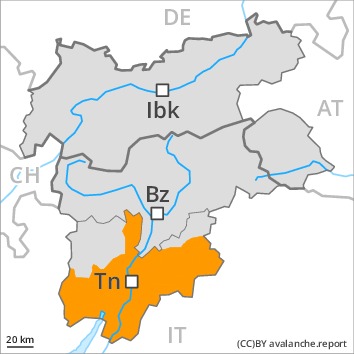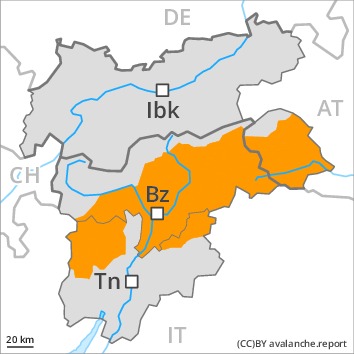
Danger level
 | treeline
|
Avalanche Problem
 | | Wind-drifted snow |
|  | |  |
 | | Gliding snow |
|  | |  |

As a consequence of the moderate to strong northwesterly wind the avalanche prone locations will become more prevalent as the day progresses.
The fresh and older wind slabs represent the main danger. The fresh snow of last week and the sometimes deep wind slabs can be released easily in all aspects and generally above the tree line. Remotely triggered avalanches are possible.
As a consequence of warming individual natural avalanches are possible towards the evening. In the regions with a lot of snow gliding avalanches are possible, even quite large ones. This applies in particular at low and intermediate altitudes.
The conditions are precarious for snow sport activities. Caution and restraint are recommended.
Snowpack
dp.6: cold, loose snow and wind
dp.2: gliding snow
The strong wind has transported the new snow. In some places new snow and wind slabs are lying on soft layers.
In its middle, the snowpack is unfavourably layered. Towards its base, the snowpack is largely stable.
Tendency
In the course of the day the wind slabs will increase in size additionally. A precarious avalanche situation will persist in some cases. Temporary increase in danger of dry and moist avalanches as a consequence of warming, in the event of solar radiation in particular at the base of rock walls.

Danger level
 | treeline
|
Avalanche Problem
 | | Wind-drifted snow |
|  | |  |
 | | Persistent weak layer |
|  | |  |

The avalanche conditions remain dangerous.
The fresh and somewhat older wind slabs are lying on unfavourable layers in all aspects. They can in many places be released, even by a single winter sport participant or triggered naturally. Caution is to be exercised in case of releases originating from, high-altitude starting zones that have retained the snow thus far, especially in the regions neighbouring those that are subject to danger level 4 (high). Avalanches can also be released in the old snowpack and reach quite a large size. Remotely triggered avalanches are possible.
In the regions with a lot of snow gliding avalanches are possible, even quite large ones. Gradual increase in danger of wet and gliding avalanches as the moisture increases. In the regions where rain falls the avalanche danger is greater. Selective safety measures may be necessary in some localities.
The conditions are precarious for snow sport activities. Caution and restraint are recommended.
Snowpack
dp.6: cold, loose snow and wind
dp.2: gliding snow
The strong wind will transport the fresh and old snow. The various wind slabs have bonded insufficiently together. In some places new snow and wind slabs are lying on soft layers.
In its middle, the snowpack is weak. Towards its base, the snowpack is largely stable. Whumpfing sounds and the formation of shooting cracks when stepping on the snowpack serve as an alarm indicating the danger.
Tendency
A precarious avalanche situation will persist in some cases. Temporary increase in danger of dry and moist avalanches as a consequence of warming, in particular below approximately 2400 m.











